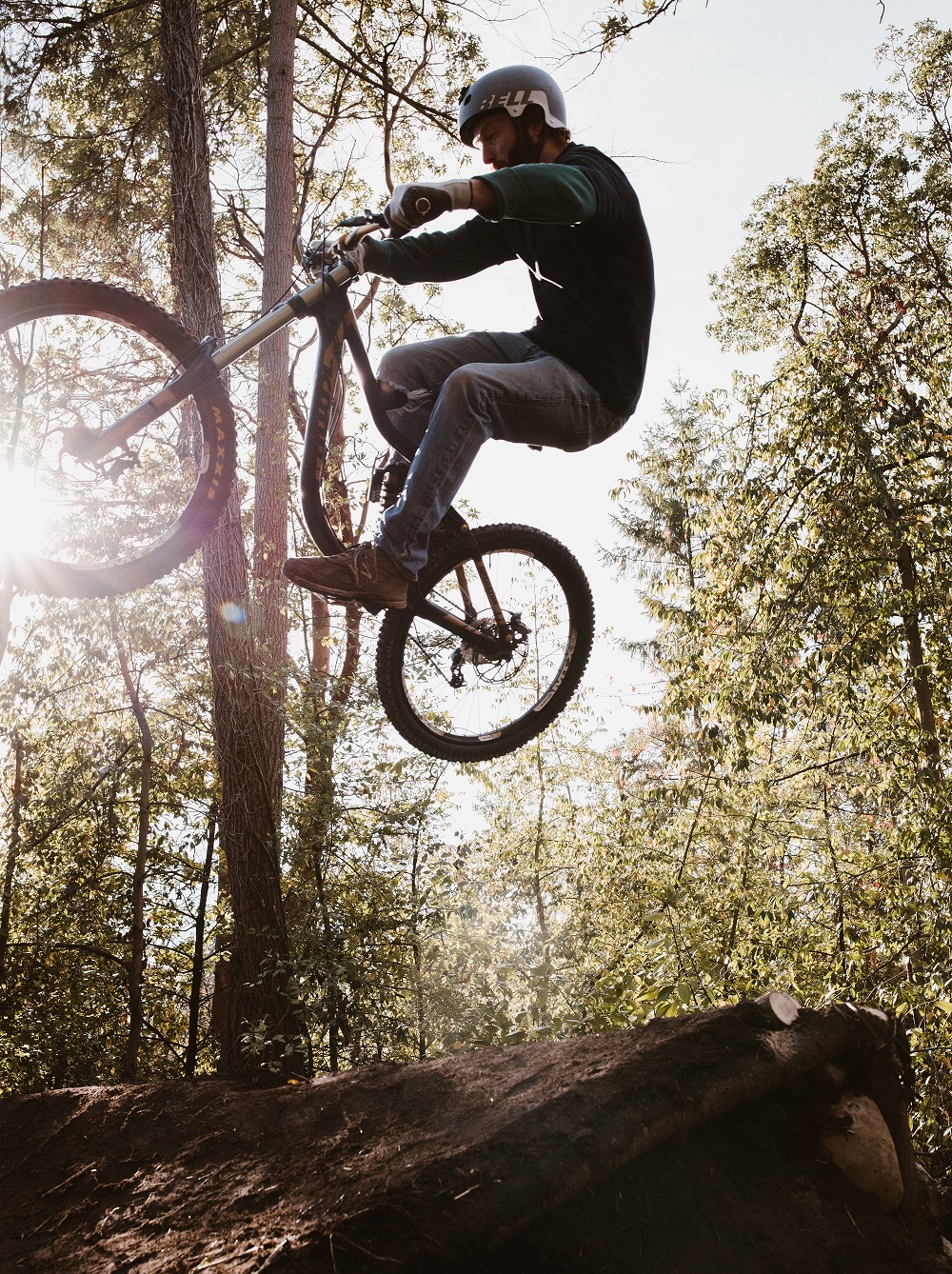Yes, you can jump a XC bike and in fact it happens all the time in normal cross country usage. Like everything else, however, there are limitations to how far you can go before you damage your bike. I certainly would only do the above on a trail bike.
Mountain bikes can be very expensive to say the least. Getting 2 different mountain bikes, one cross country and one trail, easily doubles the expenses. Naturally the question is how far can they cross over and still handle it fine? Can you use a XC bike for at least some exciting terrain and if so, how far?
Before we talk about what is safe, and what is probably ok, to do on a xc bike, let’s point out what will likely happen if you push it too far. What happens on jumps that are bigger is that the suspension won’t be enough to cushion the landing and the frame will take the stress. The most common issue that comes about from pushing it too far is cracking the frame. With the cost of some of these frames, not the best thing to happen.
It’s also possible when the frame cracks that the rider can get injured as a crash is the normal course.
The short answer is that you can probably do up to 2 foot jumps along the trails and be fine on a good quality xc bike. I have heard of people who say they do 4-foot jumps with no issues but with how expensive these bikes are, why push the limits. If the jump is too big on downhill, just go around it or slow down a little so the bike lives to ride another day. If it’s a big drop, just take a path around it and enjoy the rest of the course.
What’s Normal For a XC Bike?

Many people think of XC bikes as only riding on flat paths, and for the most part that is correct. XC racing is primarily for speed more than adrenaline in a dash for the finish line. Cross country bike riders frequently like to train hard and test their skills against other riders.
But can you jump with a XC bike, and if so what is a good idea of keeping it under?
XC bikes do not naturally lend themselves to jumping that well due to the rider leaning more forward and the bikes having a little weight to them. Drops that you can encounter on downhill trails are just gravity pulling you down and can be deceiving with how much stress they can put on a bike.
The thing is, I keep many of jumps to within a foot or two total distance. It’s safe but I value my bike. To give you an idea, in the picture above that is around a foot of distance.
Sometimes words alone can’t describe what a normal XC bike run would be. Here is a run that someone (not me) uploaded to YouTube after using a Go Pro on Spooky Woods for you to watch. This is a fairly tame XC run. Most of those drops you see are within a foot so plenty safe to do.
Can You Use a XC Bike on a Downhill Trail?
Yes, you can use a cross country bike on some downhill trails, but it comes with some caveats. And not all of them have to do with gravity and jumps.
You can use the cross country bike if you don’t do any big drops and jumps. Basically it’s the force with which you hit the ground and the ground stops you that can hurt the bike. If you land on the downslope of a hill, it does minimize the impact so it helps the shock to the frame.
If your cross countrybike is a hardtail (no rear suspension), then it is going to be brutal on the downhill. Things like rocks and roots and the like are going to shock the rear of your bike and you’re going to feel it, both now and later. If you do have some rear suspension it is going to go a long way.
Interestingly, hardtails are sometimes used on downhill trails on purpose. When you as a rider are isolated from the impact of what you are going over, you just bash through any old way. When you feel it like with a hardtail, you learn to take a more gentle path. It can actually be used as a training method.
If you have a carbon frame, there is the chance of rocks getting thrown up into your downtube and causing damage as well.
Last but not least, if you don’t have a dropper seat, you should at least lower your seat. You want to be on your feet more than sitting for many of these downhill trails. I doubt that’s new information but important nonetheless.
Just remember to take it easy and go as wild as the trail bikes and you can run a downhill trail on what is now a dual-purpose bike. It’s time to hone those mtb skills!
What’s Risky Trail-Wise On a XC Bike?

Anything that lets you come back to the ground with a bit of force is going to run the risk of damaging your bike’s frame. That means that any jump that is like 3 foot or above could cause some damage when you hit the ground. Any drop off like riding off a big rock and dropping down 3 foot could do the same damage.
So what that means if you hit a big drop like in the picture above your bike may never be the same.
2 foot is about the max of what I would do and sometimes not even. While it may be fine today and one or two drops may not instantly crack the frame, it can weaken it and shorten the life of it.
If it’s a hardtail, running over rough terrain on downhills could cause you to lose control and crash. That is more of a risk of hurting yourself than the bike in reality.
While it can happen on any trails, some of the bigger trails can cause you to kick up some sizeable rocks against the frame, or more specifically the downtube, and crack it. Especially if it’s carbon.
If you’re smart you can probably some at least a healthy chunk of moderate downhill trails.
This goes without saying, but if you’re stepping up to doing some level of downhill trails, there is more risk of head and facial damage so stepping up to a full face helmet is a really good idea.
What Can You Do To Make a XC Bike Better on Downhill Trails?
There are a few things you can do if you plan to use a XC bike on at least a limited basis on some reasonable downhill trails. Being that it’s probably too late if you have a hardtail, I won’t mention that having at least some level of rear suspension would be really handy.
- I would first put a dropper post on if you haven’t already. Especially if you plan on using it on downhill often. This one from PNW not only works well but the company is really easy to work with.
- To protect your frame from damage, there are 2 options. One is this frame guard that you can get on Amazon and it’s quick and easy and will help quite well to avoiding frame damage. If you have a carbon frame, it’s especially good to do something. The other option that I have done is to cut open a 2-liter bottle and use the plastic to wrap around the bottom of the frame and zip-tie it in place. Cheap and easy.
- Use caution. That is, don’t do avoid the extreme stuff and your bike will thank you for it.
- Be prepared. Bring your essential gear with you at all times so you can handle either something on the bike or yourself getting damaged.
Want to read more about XC bikes vs trail bikes? Then read my post on comparing the XC bike to a trail bike.
Those are about the best things you can do other than just use your head and have fun!






